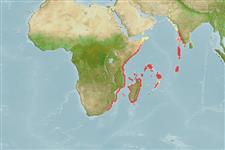>
Tetraodontiformes (Puffers and filefishes) >
Aracanidae (Deepwater boxfishes)
Etymology: Kentrocapros: Greek, kentron = sting + Greek, kapros = goat (Ref. 45335).
Eponymy: Dr Antonio Augusto da Rosa Pinto (1904-1986) was a Portuguese ornithologist. He wrote on several national parks and their avi¬faunas, and a standard w (Ref. 128868), visit book page.
More on author: Smith.
Environment: milieu / climate zone / depth range / distribution range
Ecología
marino demersal; rango de profundidad 125 - 250 m (Ref. 10909). Tropical
Western Indian Ocean: including the Vema Seamount in eastern South Atlantic
Tamaño / Peso / Age
Maturity: Lm ? range ? - ? cm
Max length : 14.3 cm SL macho / no sexado; (Ref. 10909); 9.1 cm TL (female)
Short description
Claves de identificación | Morfología | Morfometría
Espinas dorsales (total) : 0; Radios blandos dorsales (total) : 10 - 11; Espinas anales: 0; Radios blandos anales: 10 - 11. Body brownish grey, dark brown spots dorsally and on caudal peduncle; silver band from head, one leading to the caudal base, the other to the pectoral base; fins yellow; dark posterior margin on caudal fin; lips dark brown (Ref. 3141).
Life cycle and mating behavior
Madurez | Reproducción | Puesta | Huevos | Fecundidad | Larva
Smith, M.M., 1986. Ostraciidae. p. 890-893. In M.M. Smith and P.C. Heemstra (eds.) Smiths' sea fishes. Springer-Verlag, Berlin. (Ref. 3141)
IUCN Red List Status (Ref. 130435: Version 2024-1)
Threat to humans
Harmless
Human uses
Herramientas
Special reports
Download XML
Fuentes de Internet
Estimates based on models
Preferred temperature (Ref.
123201): 14.7 - 19.8, mean 17.6 °C (based on 22 cells).
Phylogenetic diversity index (Ref.
82804): PD
50 = 0.5627 [Uniqueness, from 0.5 = low to 2.0 = high].
Bayesian length-weight: a=0.01995 (0.00906 - 0.04395), b=3.01 (2.83 - 3.19), in cm total length, based on all LWR estimates for this body shape (Ref.
93245).
Nivel trófico (Ref.
69278): 3.3 ±0.5 se; based on size and trophs of closest relatives
Fishing Vulnerability (Ref.
59153): Low vulnerability (10 of 100).
